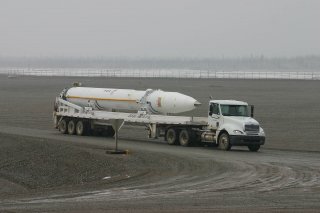The Only Way America Could Stop a North Korean Nuclear Attack
And its severly underfunded.
Donald Trump is exerting heavy pressure both publicly and privately on Beijing over North Korea while warning Americans and the world that conflict with the hermit kingdom may be imminent.
The nuclear missile launch capabilities of Kim Jung Un’s fiefdom may be limited for now – with repeated failed missile launches becoming routine – but the U.S. cannot become complacent with the permanent inadequacies of the North Korean program.
As President Donald Trump told Reuters last week, “There is a chance that we could end up having a major, major conflict with North Korea. Absolutely."
That chance is not slim with Kim and his regime apparently eager to test the new president and catch their South Korean counterparts off-guard. It seems the tense peace that has more-or-less held for over six decades could erupt into a hot war at any moment. Conflict with the secretive communist country may be a matter of when, not if, the tensions boil over into all-out war.
Although intelligence currently suggests the North Koreans are years away from hitting the American mainland with a nuclear-armed missile, they are not that far off. A few breakthroughs or the transfer (or illegal acquisition) of technology from a hostile power could accelerate that time frame.
It is the imperative that the government takes every option available to prevent that scenario we are ill-prepared to stop a targeted missile from North Korea at present.
That must change. We need a missile defense system urgently that can protect both the U.S. homeland and our allies from the North Koreans and other dangerous regimes.
There is only one system that currently has the capabilities to stop these missiles from reaching the U.S. homeland, but it requires Congress and the White House to act. Ground-based Midcourse Defense (GMD), if properly funded and strategically deployed, can best secure American cities against the devastation that would result from a nuclear blast – millions of innocents killed and the trillions of dollars in economic disruption.
However, Washington is asleep at the switch on the funding front – putting a paltry $1 billion per year into the system.
Critics claim that GMD has proven less than effective than promised, but that is because it is severely underfunded, allowing too few tests and preventing continuous improvement upgrades that would be standard operating procedure for the rollout of any other new defense system.
The difficulty of hitting a “bullet with a bullet” is obvious but the Pentagon employs “shot doctrine” to fire multiple interceptors at a single warhead to increase the odds of contact in the earth’s atmosphere.
The problem is that after years of neglect under Obama’s Pentagon budgets, there are too few interceptors being deployed – a few dozen to date with eight more slated to come online by year’s end.
Make no mistake, GMD is getting better even with limited resources. It successfully took out a mock missile last year.
But delays and continued carping about a far from perfect system are dangerous. Our defense posture requires we have more than diplomatic means to curtail and eliminate the North Korea missile threat. Deterrence doctrine does not work with an irrational regime like Pyongyang – we need to develop and deploy means to protect Americans, and GMD is, in many ways, the last best hope to do so.
Washington must wise up and pony up the investment to improve and perfect GMD before it is too late. Our lives depend on it.
Sean Kennedy is a visiting fellow at the Lexington Institute, a nonpartisan think tank specializing in defense analysis based in Arlington, Va.
This first appeared in RealClearDefense here.

